The Global Kale Extract Skincare Market is expected to record a valuation of USD 1,236.1 million in 2025 and USD 3,952.3 million in 2035, with an increase of USD 2,716.2 million, which equals a growth of over 219% across the decade. The overall expansion represents a CAGR of 12.3% and more than a 3X increase in market size.
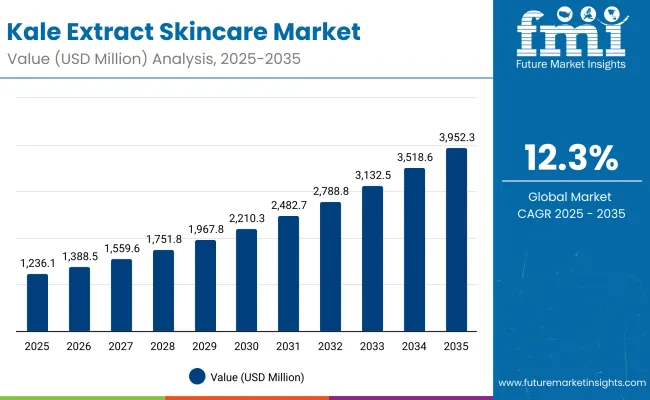
| Metric | Value |
|---|---|
| Global Kale Extract Skincare Market Estimated Value in (2025E) | USD 1,236.1 million |
| Global Kale Extract Skincare Market Forecast Value in (2035F) | USD 3,952.3 million |
| Forecast CAGR (2025 to 2035) | 12.3% |
During the first five-year period from 2025 to 2030, the market increases from USD 1,236.1 million to USD 2,210.3 million, adding USD 974.2 million, which accounts for nearly 36% of the total decade growth. This phase records steady adoption in antioxidant-based detoxifying products such as serums, creams, and masks, driven by consumers’ growing emphasis on natural/organic and vegan formulations. E-commerce dominates this period, catering to nearly half of the global consumer base and emerging as the preferred distribution channel.
The second half from 2030 to 2035 contributes USD 1,742 million, equal to 64% of total growth, as the market jumps from USD 2,210.3 million to USD 3,952.3 million. This acceleration is powered by rapid adoption of dermatologist-tested product lines, innovation in pollution-protection claims, and growing penetration in Asian markets such as China, India, and Japan. China expands at a CAGR of 23.1%, India at 25.1%, and Japan at 18%, making Asia the fastest-growing region. By 2035, premium clean-label products and subscription-based e-commerce bundles further reshape consumer expectations and fuel recurring revenue streams.
From 2020 to 2024, the Global Kale Extract Skincare Market expanded steadily, transitioning from niche clean-beauty adoption into mainstream superfood-based skincare. During this period, indie brands such as Youth To The People and Herbivore Botanicals shaped the competitive landscape, controlling more than half of segment revenues with positioning around natural/organic, vegan, and sustainable product claims. Multinational players like L’Oréal and The Body Shop strengthened their portfolios by incorporating kale extract in premium serums, masks, and creams, highlighting transparency and eco-friendly practices. Competitive differentiation in this early phase relied on storytelling around plant-based efficacy and environmentally responsible sourcing.
Demand for kale extract skincare expands further in 2025, with detoxifying/antioxidant claims capturing consumer attention. Natural/organic remains the leading claim, while e-commerce drives channel transformation. Traditional multinationals face intense competition from niche digital-first brands that specialize in vegan, clean-label, and dermatologist-tested products. The competitive advantage is increasingly shifting away from scale and distribution alone to brand authenticity, digital-first engagement, and consumer trust built on ingredient transparency.
The Global Kale Extract Skincare Market is growing due to the dual role of kale extract as both a nutrient powerhouse and a functional skincare ingredient. Its high concentration of antioxidants, vitamins, and minerals supports detoxifying and anti-aging benefits, which resonate strongly with urban consumers exposed to pollution and lifestyle stress. In 2025, detoxifying/antioxidant claims already capture more than 52% of the market, highlighting its role as the dominant function.
The rise of natural/organic and vegan claims adds further momentum, with these categories holding over 50% of value share in 2025. Consumer perception of kale as a “superfood for skin” aligns with broader wellness trends, driving strong adoption across serums, creams, and masks. Expansion of e-commerce and specialty beauty stores as primary channels enhances market accessibility, while dermatology-backed formulations are gaining credibility among professional skincare users.
Growth is also driven by product innovations such as pollution-protection creams in Asia, subscription-based serum packs in North America, and clean-label certifications in Europe. By 2035, the market will reflect a significant structural shift toward digital-first retail, transparency-driven branding, and multifunctional claims.
The market is segmented by function, product type, channel, and claim, reflecting diverse consumer preferences. Functional segmentation includes anti-aging, detoxifying/antioxidant, skin brightening, and pollution protection. Product type spans serums, creams/lotions, masks, and cleansers. Channels include e-commerce, specialty beauty stores, pharmacies, and mass retail. Claims cover natural/organic, vegan, clean-label, and dermatologist-tested.
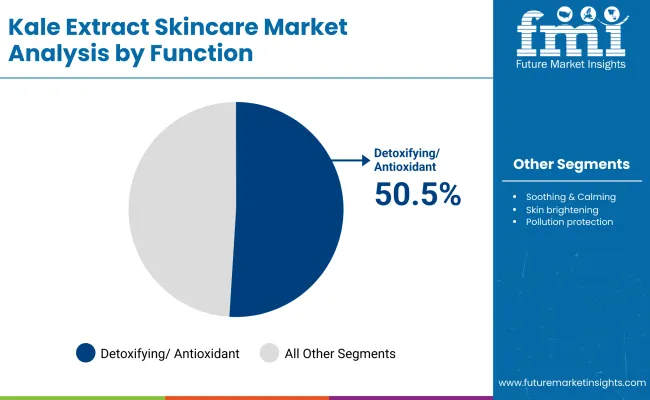
| Function Segment | Market Value Share, 2025 |
|---|---|
| Detoxifying/antioxidant | 50.5% |
| Others | 49.5% |
The detoxifying/antioxidant segment is projected to contribute 50.5% of the Global Kale Extract Skincare Market revenue in 2025, making it the leading functional category. Rising consumer concern with urban pollution and lifestyle-induced oxidative stress continues to elevate demand for detoxifying solutions. Kale extract, rich in vitamins A, C, and K, is particularly effective for skin renewal, hydration, and free-radical defense.
Premium brands leverage this function in targeted serums and creams, while mass-market players adapt it into affordable cleansers and lotions. As dermatology-backed marketing grows and anti-pollution skincare becomes mainstream, the detoxifying/antioxidant segment will sustain its leadership role and expand its influence globally.

| Product Type Segment | Market Value Share, 2025 |
|---|---|
| Serums | 52.5% |
| Others | 47.5% |
The serum segment is forecasted to dominate the Global Kale Extract Skincare Market in 2025 with 52.5% share, reflecting strong consumer preference for concentrated, high-performance products. Kale extract serums deliver potent antioxidant benefits in lightweight, fast-absorbing formats, making them suitable for multi-step skincare routines.
This category benefits from premium positioning in both e-commerce and specialty beauty stores, with subscription models and influencer-driven marketing accelerating adoption. Younger consumers, particularly millennials and Gen Z, prefer serums for their efficacy in brightening, anti-aging, and detoxifying results. As clean-label and natural formulations become mainstream, serums are expected to sustain their dominance as the go-to product format for kale extract skincare globally.
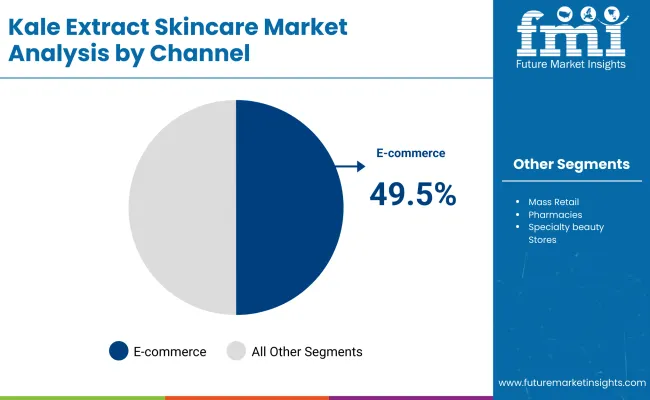
| Channel Segment | Market Value Share, 2025 |
|---|---|
| E-commerce | 49.5% |
| Others | 50.5% |
E-commerce is projected to account for 49.5% of the Global Kale Extract Skincare Market in 2025, equating to USD 593.9 million, nearly on par with offline and other retail formats at USD 624.29 million. This near balance highlights the structural transition of beauty retail, where digital platforms are becoming as critical as traditional specialty and mass retail outlets. Kale extract skincare, being positioned as a clean-label, niche ingredient-led category, aligns strongly with e-commerce discovery, where consumers actively search for vegan, organic, and dermatologist-tested claims.
The segment’s strength lies in its synergy with digital-first indie brands such as Youth To The People, Herbivore Botanicals, and Glow Recipe, which rely heavily on D2C websites, subscription models, and influencer-driven marketing to capture Gen Z and millennial buyers. Social commerce, particularly through Instagram, TikTok, and Douyin, has amplified brand narratives around kale as a “superfood for skin,” making e-commerce a natural fit for education and engagement. By 2035, e-commerce is expected to decisively surpass traditional channels, benefiting from personalization algorithms, subscription-driven product bundles, and virtual try-on tools. The shift toward digital-first retail ecosystems positions e-commerce as the backbone of long-term growth in the Global Kale Extract Skincare Market.
Rising Demand for Antioxidant-Rich “Superfood Skincare”
The first major driver for the Global Kale Extract Skincare Market is the increasing consumer adoption of superfood-based skincare products, where kale is positioned as a premium “antioxidant powerhouse.” Kale extract is rich in vitamins A, C, and K, flavonoids, and polyphenols, which deliver proven benefits for detoxification, anti-aging, and skin brightening. In a market where 52.5% of sales in 2025 are already linked to detoxifying/antioxidant functions, kale extract is uniquely positioned as a “functional ingredient” rather than a passing trend. Unlike other botanicals, kale aligns with the wider food-beauty crossover movement, where consumers seek ingredients they already trust in their diet. This positioning boosts product credibility and consumer willingness to pay a premium, particularly in the serum and mask categories. Brands such as Youth To The People and Juice Beauty have built their market success around this very narrative, and their growth has influenced multinationals like L’Oréal to follow suit with clean-label, kale-driven lines.
E-commerce and Digital-First Distribution Channels
Another critical driver is the near 50% share of e-commerce sales in 2025, signaling a structural shift in distribution. The Global Kale Extract Skincare Market benefits from being particularly suited to online-first growth due to its positioning around niche claims (vegan, clean-label, organic). Consumers researching these claims often rely on social media, influencer reviews, and direct-to-consumer (D2C) websites. This makes digital-native brands like Herbivore Botanicals and Glow Recipe extremely competitive, as they can leverage storytelling, subscription models, and influencer-driven campaigns to quickly capture younger demographics. By 2035, subscription-based serum and mask kits, often bundled with personalization algorithms, will drive recurring revenue and long-term customer loyalty. The alignment of kale extract skincare with online discovery and social commerce is not only accelerating sales but also lowering entry barriers for indie brands that otherwise could not compete in traditional retail channels.
High Price Sensitivity in Mass-Market Segments
While premium kale extract products thrive in e-commerce and specialty stores, one of the strongest restraints is price sensitivity in mainstream retail. Kale extract skincare, particularly in serums, is often positioned as a premium clean-label solution and carries a price tag significantly higher than conventional products. For example, average kale extract serums in 2025 are priced at 1.5x-2x higher than standard vitamin C or hyaluronic acid serums. In emerging markets such as India, where CAGR is projected at 25.1%, mass consumers remain highly price-sensitive, which restricts adoption beyond urban, affluent segments. Without localized sourcing strategies or affordable formulations, multinational players risk losing growth potential in middle-tier retail and pharmacy chains.
Supply Chain and Ingredient Standardization Challenges
Another market restraint is the lack of standardized extraction and quality protocols for kale extract. Unlike widely regulated actives such as retinol or niacinamide, kale extract is still considered a botanical ingredient with significant variability in potency depending on source, farming practices, and extraction methods. This inconsistency creates challenges for multinational players who need scalable, GMP-compliant supply chains. Small indie brands often emphasize “farm-to-face” sourcing, but this model is not feasible for large-scale expansion. Moreover, kale is perishable and seasonal, making consistent sourcing more complex compared to dried or powdered botanicals. These factors add cost pressure and regulatory risk, particularly in Europe where clean-label certifications are tightly enforced.
Shift Toward Pollution-Protection and Urban Defense Claims
One of the most prominent trends in the Global Kale Extract Skincare Market is the rising demand for pollution-protection products, particularly in Asia-Pacific cities such as Beijing, Shanghai, and Delhi, where urban pollution levels are high. By 2030, formulations combining kale extract with anti-pollution complexes are expected to capture significant share, especially in creams and lotions marketed as “daily defense” skincare. Pollution protection is becoming an anchor claim alongside detoxifying/antioxidant, helping brands diversify beyond anti-aging. Japanese and Korean brands are already leveraging this positioning, which explains Japan’s high projected CAGR of 18%. By 2035, pollution-protection creams enriched with kale extract will become mainstream in both premium and mass retail segments.
Premiumization Through Dermatologist-Tested and Clinical Validation
Another strong trend is the premiumization of kale extract skincare through dermatologist-tested claims. Historically, kale extract products have been marketed under the umbrella of “natural/organic” and “vegan,” but consumers are increasingly skeptical and demand scientific validation. Dermatologist-tested claims, clinical efficacy studies, and third-party certifications are becoming central to brand credibility. This trend has enabled brands like Murad and Fresh to expand their kale extract portfolios with medical-grade positioning, appealing to professional skincare buyers and dermatology clinics. By 2035, dermatologist-tested kale extract skincare is expected to move beyond niche premium lines and become a standard expectation for mid-market consumers as well, reshaping competitive dynamics.
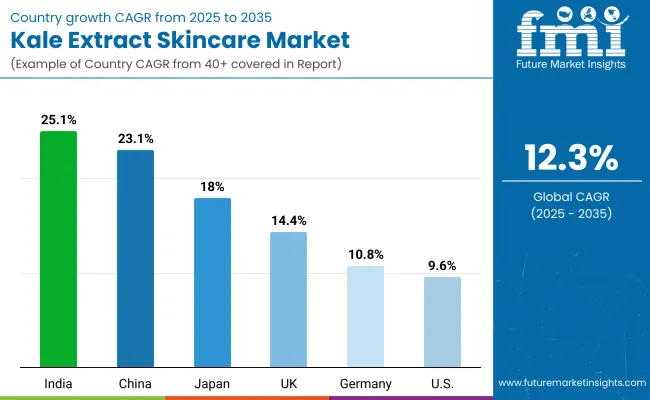
| Countries | Estimated CAGR (2025 to 2035) |
|---|---|
| China | 23.1% |
| USA | 9.6% |
| India | 25.1% |
| UK | 14.4% |
| Germany | 10.8% |
| Japan | 18.0% |
Between 2025 and 2035, the Global Kale Extract Skincare Market will witness its fastest growth in India (25.1% CAGR) and China (23.1% CAGR), reflecting the strong pull of wellness-driven and natural skincare trends across Asia. In India, the convergence of ayurveda-inspired clean beauty and the rapid expansion of e-commerce platforms such as Nykaa and Purplle has created a fertile ground for kale extract formulations. Urban millennials and Gen Z consumers are particularly drawn to detoxifying/antioxidant claims, with serums and creams positioned as affordable luxury. Similarly, China benefits from its premiumization of skincare routines, with kale extract integrated into serums, sheet masks, and pollution-protection creams tailored to high urban pollution exposure. The rising influence of K-beauty and C-beauty, coupled with an appetite for natural/organic claims (53.5% share in 2025 for China), ensures kale extract becomes a trusted superfood ingredient in mainstream skincare by 2035. Japan, with an 18% CAGR, is also a significant contributor, leveraging its established dermocosmetics industry to incorporate kale extract into dermatologist-tested products and clinical-grade offerings.
Meanwhile, Western markets demonstrate steady but slower growth, led by the UK at 14.4% CAGR and Germany at 10.8% CAGR, reflecting the maturity of clean-label skincare adoption in Europe. These regions are seeing a shift from novelty to sustained demand, with kale extract becoming a standard ingredient in vegan, sustainable, and dermatologist-tested ranges. Germany’s strict regulatory standards are pushing brands toward greater ingredient standardization and certification, boosting consumer trust. In the USA, the market expands at a 9.6% CAGR, with revenues rising from USD 272.6 million in 2025 to USD 814.7 million by 2035. Growth here is shaped by indie brands like Youth To The People and large-scale players like L’Oréal, who are leveraging e-commerce, influencer-driven marketing, and subscription models. However, compared to Asia, growth in the USA and Europe is tempered by price sensitivity and the broader saturation of natural/organic skincare, leading to a competitive shift toward clinical validation and dermatologist-tested claims as key differentiators.
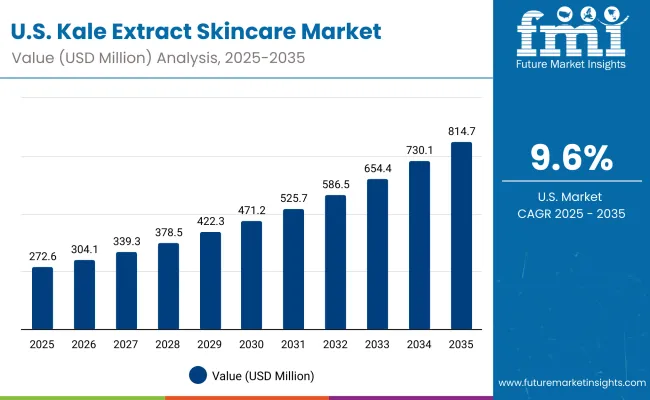
| Year | USA Kale Extract Skincare Market (USD Million) |
|---|---|
| 2025 | 272.6 |
| 2026 | 304.1 |
| 2027 | 339.3 |
| 2028 | 378.6 |
| 2029 | 422.4 |
| 2030 | 471.2 |
| 2031 | 525.8 |
| 2032 | 586.6 |
| 2033 | 654.5 |
| 2034 | 730.2 |
| 2035 | 814.7 |
The Global Kale Extract Skincare Market in the United States is projected to grow at a CAGR of 9.6%, led by premiumization in anti-aging and detoxifying product categories. Consumer adoption is being driven by serums and creams, where indie brands such as Youth To The People dominate, supported by large-scale players like L’Oréal. The USA market demonstrates a strong preference for dermatologist-tested and clinically validated claims, which are increasingly bundled with natural/organic positioning. E-commerce channels are a key enabler, representing nearly half of sales by 2025, with subscription-driven launches adding recurring revenue streams.
The Global Kale Extract Skincare Market in the United Kingdom is expected to grow at a CAGR of 14.4%, supported by strong demand for natural/organic and vegan-certified products. The UK consumer base is shifting toward clean-label claims, particularly in masks and creams, while e-commerce and specialty beauty stores serve as the main growth channels. Premium players are leveraging sustainability certifications and eco-friendly packaging to appeal to environmentally conscious consumers. Collaborations with dermatology professionals and beauty retailers continue to build credibility, while mid-market chains expand private-label offerings with kale extract as a differentiator.
India is witnessing rapid growth in the Global Kale Extract Skincare Market, which is forecast to expand at a CAGR of 25.1% through 2035, the fastest globally. Rising urbanization, digital adoption, and ayurveda-inspired beauty preferences are fueling awareness of kale as a detoxifying and skin-brightening ingredient. Affordable launches by both multinational and local players are penetrating tier-2 and tier-3 cities, while premium e-commerce platforms target affluent millennials in metropolitan hubs. Educational campaigns around antioxidants and urban skin defense are helping to build brand trust, while distribution partnerships with pharmacies and specialty beauty retailers are expanding access.
The Global Kale Extract Skincare Market in China is expected to grow at a CAGR of 23.1%, among the highest worldwide. Growth momentum is driven by premium skincare adoption, city-level pollution-protection demand, and strong local competition. Kale extract is increasingly integrated into serums, sheet masks, and anti-pollution creams, aligning with Chinese consumers’ desire for multifunctional products. Domestic players leverage competitive pricing, while multinationals differentiate through clean-label and dermatologist-tested positioning. E-commerce and social commerce platforms, including Tmall and Douyin, are central to consumer discovery and loyalty.
| Countries | 2025 Share (%) |
|---|---|
| USA | 22.1% |
| China | 11.8% |
| Japan | 6.9% |
| Germany | 15.3% |
| UK | 8.4% |
| India | 5.2% |
| Countries | 2035 Share (%) |
|---|---|
| USA | 20.6% |
| China | 12.8% |
| Japan | 9.8% |
| Germany | 13.3% |
| UK | 7.2% |
| India | 5.9% |

| Function Segment | Market Value Share, 2025 |
|---|---|
| Detoxifying/antioxidant | 57.3% |
| Others | 42.7% |
The Global Kale Extract Skincare Market in the United States is valued at USD 272.59 million in 2025, with detoxifying/antioxidant products leading at 57.3%, followed by other functions at 42.7%. The dominance of detoxifying/antioxidant skincare reflects the country’s consumer demand for superfood-based, antioxidant-rich beauty products that promise visible results against oxidative stress and environmental damage. Urban consumers, especially millennials and Gen Z, are investing in serums and creams positioned as premium clean-label solutions, often bundled with dermatologist-tested validation to enhance trust.
This advantage positions detoxifying/antioxidant formulations as the foundation of growth in the USA market. While anti-aging remains a core demand driver, detoxification-oriented skincare resonates strongly with consumers living in high-stress, urban environments. Specialty beauty stores and e-commerce platforms are accelerating the reach of such products. By 2035, with USA revenues crossing USD 814.66 million, integration of kale extract with AI-powered personalized skincare regimens and subscription delivery models will further strengthen this category.
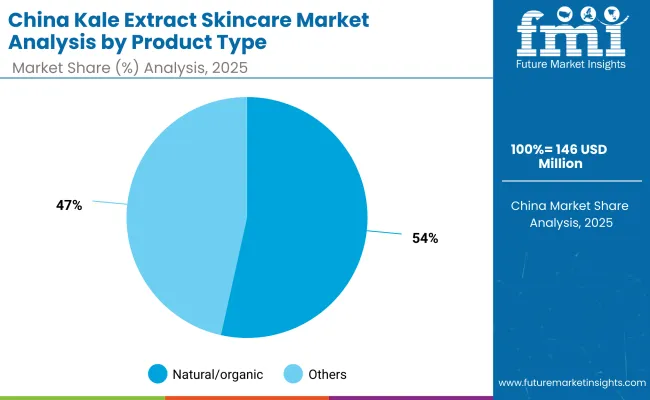
| Claim Segment | Market Value Share, 2025 |
|---|---|
| Natural/organic | 53.5% |
| Others | 46.5% |
The Global Kale Extract Skincare Market in China is valued at USD 146 million in 2025, with natural/organic claims leading at 53.5%, followed by other claims at 46.5%. The dominance of natural/organic positioning is a direct outcome of China’s consumer shift toward clean beauty, plant-based, and premium wellness-inspired skincare. These claims resonate strongly in tier-1 and tier-2 urban centers, where pollution levels and environmental stress drive consumer preference for detoxifying and protective formulations.
This advantage positions natural/organic kale extract skincare as an essential category in China’s beauty ecosystem, particularly in serums, sheet masks, and anti-pollution creams. Local e-commerce giants such as Tmall and JD.com, as well as social platforms like Douyin, are critical to consumer discovery. Domestic brands leverage competitive pricing, while global brands focus on premium certifications and dermatologist-tested claims. With China’s CAGR projected at 23.1%, the market will more than triple in size by 2035, fueled by government support for clean-label standards and the rapid rise of C-beauty innovation.
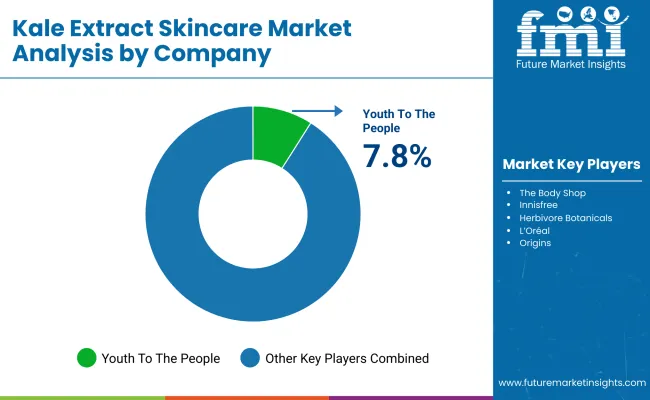
| Company | Global Value Share 2025 |
|---|---|
| Youth To The People | 7.8% |
| Others | 92.2% |
The Global Kale Extract Skincare Market is moderately fragmented, with indie clean-beauty leaders, multinational conglomerates, and niche-focused specialists competing across diverse consumer segments. Youth To The People leads with a 7.8% global share, driven by its strong positioning around superfood-powered, vegan, and eco-friendly skincare lines. Its emphasis on serums and masks has made it a trusted brand among millennial and Gen Z consumers worldwide.
Large multinationals such as L’Oréal, The Body Shop, and Innisfree hold significant presence through diversified portfolios and wide distribution networks. Their strategies emphasize scaling kale extract skincare by combining natural/organic claims with dermatologist-tested credibility. These brands also leverage sustainable packaging, clean-label marketing, and AI-powered personalization to maintain competitive positioning.
Mid-sized players including Herbivore Botanicals, Murad, Fresh, Juice Beauty, and Glow Recipe cater to premium and niche audiences, focusing on vegan-certified, cruelty-free, and influencer-driven product launches. These brands are highly relevant in digital-first channels, particularly in e-commerce and social commerce platforms.
Competitive differentiation is shifting away from ingredient novelty toward ecosystem-driven brand equity. Storytelling around sustainability, clinical validation, and digital engagement has become central to consumer trust. Brands that integrate kale extract into customizable routines, subscription models, and multi-claim formulations are gaining share, highlighting a decisive move toward authenticity, innovation, and recurring consumer engagement.
Key Developments in Global Kale Extract Skincare Market
| Item | Value |
|---|---|
| Quantitative Units | USD 1,236.1 million |
| Function | Anti-aging, Detoxifying/antioxidant, Skin brightening, and Pollution protection |
| Product Type | Serums, Creams/lotions, Masks, and Cleansers |
| Channel | E-commerce, Pharmacies, Specialty beauty stores, and Mass retail |
| Claim | Natural/organic, Vegan, Dermatologist-tested, and Clean-label |
| Regions Covered | North America, Europe, Asia-Pacific, Latin America, Middle East & Africa |
| Country Covered | United States, Canada, Germany, France, United Kingdom, China, Japan, India, Brazil, South Africa |
| Key Companies Profiled | Youth To The People, The Body Shop, Innisfree, Herbivore Botanicals, L’Oréal, Origins, Murad, Fresh, Juice Beauty, Glow Recipe |
| Additional Attributes | Dollar sales by function, product type, and channel, adoption trends in detoxifying/antioxidant and skin brightening skincare, rising demand for vegan and natural/organic claims, segment-specific growth in serums and e-commerce, integration of kale extract with other botanicals (vitamin C, niacinamide, and hyaluronic acid), regional trends influenced by K-beauty and clean-label movements, and innovations in upcycled and biotech-derived kale sourcing. |
The Global Kale Extract Skincare Market is estimated to be valued at USD 1,236.1 million in 2025.
The market size for the Global Kale Extract Skincare Market is projected to reach USD 3,952.3 million by 2035.
The Global Kale Extract Skincare Market is expected to grow at a 12.3% CAGR between 2025 and 2035.
The key product types in the Global Kale Extract Skincare Market are serums, creams/lotions, masks, and cleansers.
In terms of function, the detoxifying/antioxidant segment is projected to command 52.5% share in the Global Kale Extract Skincare Market in 2025.






Full Research Suite comprises of:
Market outlook & trends analysis
Interviews & case studies
Strategic recommendations
Vendor profiles & capabilities analysis
5-year forecasts
8 regions and 60+ country-level data splits
Market segment data splits
12 months of continuous data updates
DELIVERED AS:
PDF EXCEL ONLINE
Extraction Kits Market Analysis - Size, Share, and Forecast Outlook 2025 to 2035
Extracts and Distillates Market
Sage Extract Market Size and Share Forecast Outlook 2025 to 2035
Fume Extractor Market Size and Share Forecast Outlook 2025 to 2035
Meat Extracts Market Size and Share Forecast Outlook 2025 to 2035
Wine Extract Market Size and Share Forecast Outlook 2025 to 2035
Amla Extract Market Analysis - Size, Share, and Forecast Outlook 2025 to 2035
Dust Extractor Market Growth – Trends & Forecast 2025 to 2035
Data Extraction Software Market
Peony Extract Brightening Creams Market Analysis - Size, Share, and Forecast Outlook 2025 to 2035
Peony Extracts for Brightening Market Size and Share Forecast Outlook 2025 to 2035
Algae Extracts Market Size and Share Forecast Outlook 2025 to 2035
Juice Extraction Equipment Market Size and Share Forecast Outlook 2025 to 2035
Yucca Extract Market Size and Share Forecast Outlook 2025 to 2035
Maple Extracts Market Size and Share Forecast Outlook 2025 to 2035
Yeast Extract Market Analysis - Size, Share, and Forecast Outlook 2025 to 2035
Yeast Extract Industry Analysis in USA Size, Growth, and Forecast for 2025 to 2035
Basil Extract Market Size, Growth, and Forecast for 2025 to 2035
Understanding Yeast Extract Market Share & Key Players
Anise Extract Market Growth - Flavor Innovations & Applications 2025 to 2035

Thank you!
You will receive an email from our Business Development Manager. Please be sure to check your SPAM/JUNK folder too.
Chat With
MaRIA